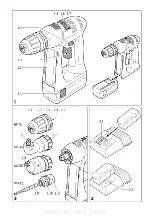
10
4
Charge battery pack
To load the battery pack, push it into the holder
(3.1) on the charger up to the stop.
Perform this in reverse to remove the battery
pack from the charger.
The battery type used (NiCd or NiMH) is detec-
ted automatically.
Charging is controlled by a microprocessor.
If a warm NiMH battery pack (>37° C) is inser-
ted, charging will only be carried out at a lower
charge current.
In this case, the charging time is extended.
The LED (3.2) indicates the respective
charging state of the charger.
LED yellow – steady:
Charger is ready for use.
LED green – fl ashing:
Battery pack being charged.
LED green – steady:
Battery pack fully charged, conservation char-
ge on.
LED red – fl ashing:
General malfunction, e. g. full contact not
being made, short-circuit, battery pack faul-
ty.
LED red – steady:
Temperature of battery pack is outside per-
missible limit.
It is essential that you read the
instructions in the Chapter „Wor-
king instructions - Maintenance
- Care“.
5 Working
with
the
machine
5.1
Initial operation
Turn on by pressing button (1.3). Depending on
the pressure exerted on the button, the adjust-
ment of running speed can be varied infi nitely.
Turn off by releasing the button (1.3).
After releasing the button, the chuck is stopped
and therefore, after-running of the equipment
is prevented.
5.2 Bit
storage
well
You can insert several bits or bit extensions into
the bit magazine (1.2) with magnetic holder.
5.3
Warning signal
With the following operational statuses, the
machine sounds an acoustic warning signal and
switches off:
Peep at regular intervals
- Battery empty
Triple peep at regular intervals
- Excessive load (torque)
- Machine too warm.
6
lnstructions on application - main-
tenance - care
Please pay attention to the follo-
wing instructions. Otherwise the-
re is a risk of damage to the tool,
charger or battery pack.
- Repairs may only be performed by authorised
technicians. LC 45 charging device: Even after
disconnection from the mains, there is still a
high capacitor voltage on the power output
component on the inside of the device.
- Keep the air vents of the electronic equipment
and the charger clean to guarantee the air
circulation for cooling.
- No metal objects (metal chips) should enter
the charger at the contact points as well as
through the cooling slits into the equipment
(danger of short circuit).
- Only use original Festool battery packs.
Do not use spent and recycled battery packs.
The user shall be liable for damages if Festool
original battery packs are not used.
- Keep the connection contacts of electronic
equipment, charger and battery pack clean.
- By keeping the battery pack in a ready for use
charger, the battery pack will be kept in a state
of readiness by fl oat charging conservation.
- Do not keep discharged battery pack (maxi-
mum one month) attached to charger whe-
never charger is detached from the power
supply (danger of deep discharging).
- A new battery pack or a battery pack not used
for a longer period of time reaches it full ca-
pacity after about 5 charging and discharging
cycles.
- Battery packs should, before charging, be fully
discharged if possible.
Continuous starting of the charging process
shortens the lifespan of the batteries.
- A considerably reduced time of operation per
charging shows that the battery pack is used
up an should be replaced by a new one.
- NiCd battery packs that are not used for lon-
ger periods should be stored in a discharged
state.
Special instructions for NiMH battery
packs:
- The output of NiMH battery packs drops
noticeably at ambient temperatures below 0°
C or above 45° C.
- Do not overload the tool (do not load the tool
excessively so that it comes to a standstill).
- Even if NiMH battery packs are not used, re-
charge them approx. every 4 months so that
they retain their full capacity.
- NiMH battery packs should be left for 60 min.
in the charger after every 10th fast charge
to compensate any differences in capacity
between the cells.
- Because NiMH battery packs discharge auto-
matically, store them preferably at ambient
temperatures of between 0° C and 25° C.
Seen at Ideal Tools.
Summary of Contents for C 12
Page 3: ...Seen at Ideal Tools ...

























